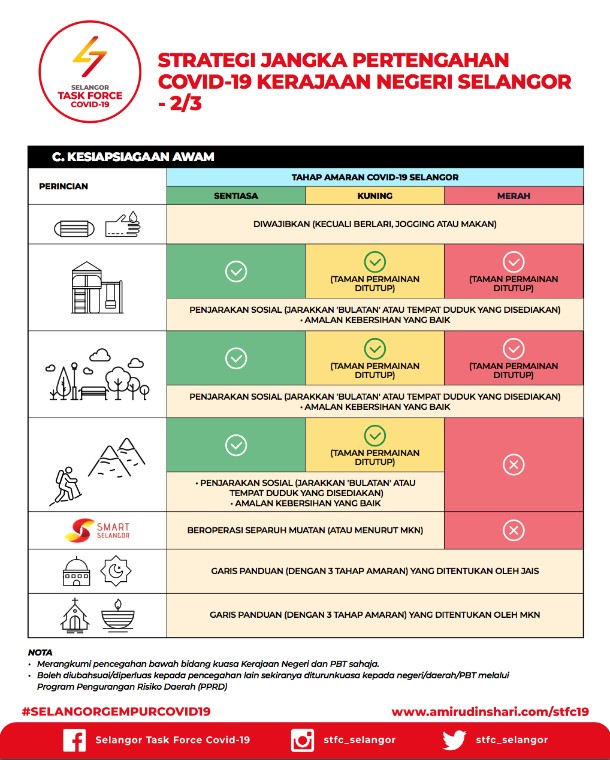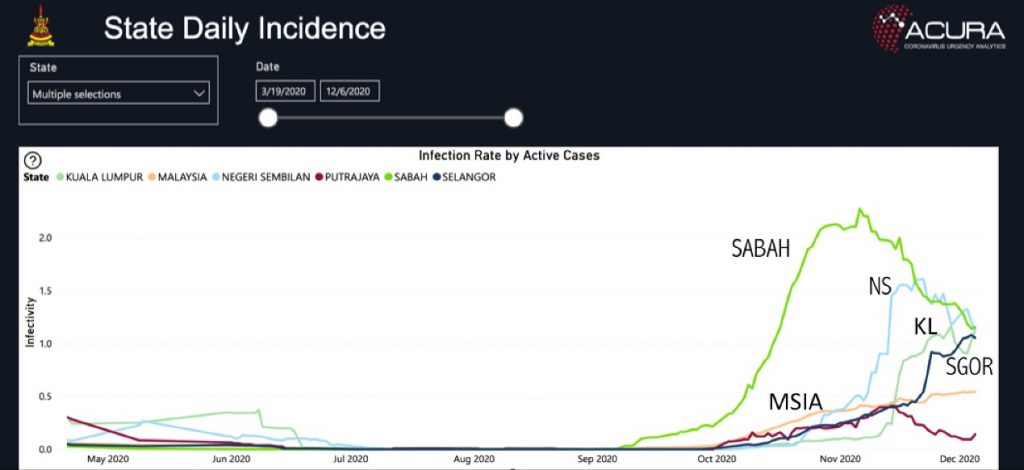Introduction
The first case of Covid-19 was notified to the world on 31 December 2019. Malaysia diagnosed its first cases of Covid-19 in three Chinese nationals on the 25th January 2020, who had close contact with an infected person in Singapore.
The first Malaysian was confirmed with Covid-19 on the 4th February 2020. The 41-year old man had returned from Singapore when he started to develop a fever and a cough.
This heralded the first wave of infection with 22 cases. 12 had a travel history to affected countries and regions. Eight cases were close contacts and two were from a humanitarian mission. There were 11 days with no cases, from 16 to 26 February 2020.
The second wave began on the 27th February 2020, unleashed by the Tabligh cluster, which gathered 16,000 people in Sri Petaling for a religious meeting from February 27 to March 1. The number of cases in Malaysia soared to 553, the highest in Southeast Asia then.
Malaysia announced restrictions on movements (MCO) for two weeks from March 18, barring its citizens from travelling overseas and shutting all businesses except shops selling food and daily necessities.
The Conditional Movement Control Order (CMCO) ceased on 9 June, and entered into the Recovery Movement Control Order (RMCO) phase between 10 June and 31 August.
After a relatively quiet September, Covid-19 cases nationwide rose sharply from 2nd October 2020, especially in Sabah, aggravated by the two-week state election campaign and an outbreak at a prison and detention centre in Tawau, Sabah, which houses illegal immigrants from the Philippines and Indonesia.
On 9th October 2020, the Ministry of Health (MOH) announced that Malaysia had entered the third wave of the Covid-19 pandemic.
The government announced the implementation of CMCO from 9th November 2020 to 6th December 2020, in all states except Perlis, Pahang, Kelantan and Sarawak.
The majority of business sectors were allowed to resume their operations and were required to abide by the strict Standard Operating Procedures (SOPs).
The need for an evidence-based, predictable, and targeted cross-sectoral approach
Changes in the SOP were announced from time to time, just in time, by the Minister, which not infrequently caused much confusion and consternation to the lay public.
Most of the time, these confusions could have been avoided if there was an evidence-based and predictable mid-term plan, covering all the relevant sectors holistically in a targeted manner (within a small geographic area) and dependent on the degree of community transmission in that vicinity (which is expected to change over the course of the pandemic). The system should also inform testing strategies which would be most appropriate for that period and place.
There are various models of alert systems which could have been emulated and modified for our national purposes which were simpler, more easily understood and rakyat-friendly. These included the 4-Level Covid-19 Alert system in New Zealand, the Tier-System in the UK ,and the Selangor Task Force on Covid (STFC) Traffic Light System (SELamat).
New Zealand
The Alert System in NZ was introduced in March 2020 to manage and minimise the risk of Covid-19. The system helps the people to understand the current level of risk and the restrictions that must be followed legally. Each of the 4-Alert Levels tells the people what measures needs to be followed and actions to be taken. The Alert Levels may be applied at a town, city, local authority, region, or national level.
They were updated on the basis of new scientific knowledge about Covid-19 and assessment of the effectiveness of the interventions in New Zealand and elsewhere.
At all Alert Levels, essential services including health services, emergency services, utilities and goods transport will remain up and running. Employers in those sectors must continue to legally satisfy their health and safety obligations.
The highest Alert Level 4 mandates a Lockdown, since the disease is not contained, with sustained and intensive community transmissions and widespread outbreaks. The range of measures in Alert Level 4 includes:
- People instructed to stay at home in their bubble other than for essential personal movement.
- Safe recreational activity is allowed in local areas.
- Travel is severely limited.
- All gatherings cancelled and all public venues closed.
- Businesses closed except for essential services e.g. supermarkets, pharmacies, clinics, petrol stations and lifeline utilities.
- Educational facilities closed.
- Rationing of supplies and requisitioning of facilities possible.
- Re-prioritisation of health care services.
In Alert Level 3 (Restrict), there are multiple cases of community transmissions with multiple active clusters in multiple regions.
In Alert Level 2 (Reduce), the disease is contained, but the risk of community transmission remains with active clusters in more than one region.
Since 7 October 2020, all of NZ has been on Alert Level 1 (Prepare). The disease is contained in New Zealand with only isolated local transmissions. However, Covid-19 is uncontrolled overseas with the risk of sporadic imported cases.
England
On 2 December 2020, the nationwide lockdown imposed on England was lifted and the country returned to a three-tier system. This means that different parts of the country have been split into Medium (Tier 1), High (Tier 2), and Very High (Tier 3), local coronavirus alert areas, with respective sets of rules depending on the categorisation of risk.
The allocation of tiers is dependent on various factors related to how the area is coping with Covid-19 infections, which includes infection rates, reproduction rates (R0) and the current and projected pressures faced by local NHS departments. The Tier allocations is reviewed every 14 days.
Currently, Kingston upon Hull has the highest infection rate in England, at 530 per 100,000 people, followed by Stoke-on-Trent (453.6) and Dudley (452.1).
The areas with the lowest infection rates are currently Mid Suffolk (56.8) and West Suffolk (61.4)
Gyms, places of worship and non-essential shops are permitted to remain open across all tiers. Pubs and restaurants are also allowed to remain open in Tiers 1 and 2, with last orders at 10pm and an 11pm curfew. In Tier 3, the hospitality sector can only stay open for takeaways and deliveries.
In Tier 1, a maximum of six people can meet outdoors or indoors, while in Tier 2, there is no mixing of households indoors and in Tier 3, households can only mix in outdoor public spaces, such as parks.
Selangor
The STFC Traffic Light System (SELamat) was built with several features in mind:
- The guidance for the public and businesses would be streamlined and simplified based on the best available evidence available and to update these regularly based on latest research.
- The focus would be holistic – rather than leaning towards a false dichotomy of lives versus livelihoods. For example, humane and mental health protecting measures such as access to outdoor recreation would be preserved as far as possible.
- Measures would be targeted at the smallest feasible geographic unit so as not to cause unnecessary harm and inconvenience in areas where community transmission is not significant.
- The guidance would cover all relevant sectors under the jurisdiction of the state, for both business and the general public, but would also cover the state’s own public health strategies, such as testing strategies and enforcement.
- The guidance would be communicated in advance and include different gradations of measures depending on the degree of community transmission, aligning as far as possible with the federal system.
- This system would hence be predictable rather than ad-hoc changes in the gradations of measures applicable that would be dependent on local community transmission and the latest available evidence – rather than abused as “arbitrary” lawmaking.
As a simple example, the guidance provided for non-Muslim places of worship, written along the principles of SELamat – with baseline measures applicable all the time and a series of community transmission dependent additional measures – was published on 26 June 2020 and has not required updates as the possibility of rising and falling community transmission was considered from the very start (see Figure IV). This allows religious stakeholders to make medium-term plans for the benefit of their adherents.




Community transmission and coloured zones
In order to align with MOH zoning and reduce public confusion, the system attempted alignment with the zoning as stipulated by the MOH, i.e. Green (0 active case), Amber (1-40 active cases), Red (>40 active cases) (Figure V).

I have long wondered what was the rational or science underlying this colour zoning system. One would think that the zoning would be based on the severity of the infection and the coping capacity of the health care and essential services in the town, city, district or state.
And this is not solely based on absolute numbers but often factored as incidence rates, infectivity rates, reproduction number (R0), or a composite of metrics for risk stratification (see Figure VI).

One such study has identified 22 fluctuating variables which may contribute to the colour of the zones, and this would require machine learning to assess on a regular basis.
It is simply too costly on livelihoods and the national economy to mandate lockdowns and MCOs based on some arbitrary measure which is not founded on good science, especially when we are nowadays powered with artificial intelligence and machine learning.
Dr Musa Mohd Nordin is a consultant paediatrician and neonatologist.
- This is the personal opinion of the writer or publication and does not necessarily represent the views of CodeBlue.




